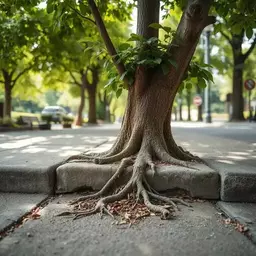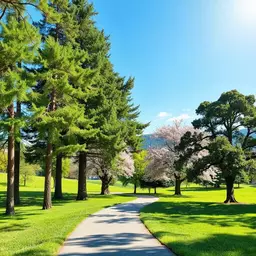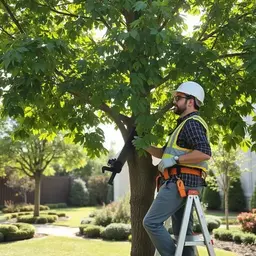Managing Tree Roots by Sidewalks
By Elena Whitmore / Oct 21
Have you ever admired a beautifully landscaped yard, only to notice cracks and uneven surfaces around the trees? The relationship between trees and hardscapes is crucial for a stunning outdoor space, but it comes with its own set of challenges. Understanding how to manage this relationship can lead to healthier trees and a more aesthetically pleasing environment.
Effective tree care requires addressing unique challenges presented by hardscapes. Below are key aspects to consider.
To maintain health:
When we think about our outdoor spaces, the coexistence of trees and hardscapes plays a vital role in their overall beauty and functionality. Trees not only provide shade and visual appeal but also contribute significantly to the ecosystem. However, integrating trees with hardscape elements like patios, walkways, and walls can present unique challenges that require careful consideration and management. At Rooted Edge, we believe understanding these dynamics is essential for creating a thriving outdoor environment.
Trees and hardscapes can complement each other beautifully when their relationship is maintained properly. Picture a sturdy oak tree standing proudly next to a smooth stone pathway—together, they create a harmonious balance. However, trees’ root systems can sometimes disrupt hardscapes, causing cracks and uneven surfaces, which can be a real headache for homeowners! For further information on managing trees near construction, the National Park Service offers valuable insights into protecting historic trees during construction.
Maintaining tree health near hardscapes comes with its own set of challenges. One major concern is ensuring that trees receive adequate water and nutrients while avoiding damage to surrounding structures. As an arborist and landscape designer, I’ve seen firsthand how improper care can lead to issues like root distress and nutrient deficiencies. The Arbor Day Foundation provides extensive resources on general tree care and maintenance that can help address these concerns.
By recognizing and addressing these challenges, we can create a healthier relationship between trees and hardscapes. At Rooted Edge, our mission is to empower homeowners with the knowledge and tools to navigate these complexities while embracing the beauty and functionality of their landscapes.
Did you know? Regularly mulching around the base of your trees can help mitigate some of the challenges posed by hardscapes. Mulch retains moisture, prevents soil compaction, and provides essential nutrients, all of which contribute to healthier tree growth and a more stable root system. Just be sure to keep mulch away from the trunk to prevent rot!
When it comes to integrating trees with hardscapes, many homeowners have similar concerns. One of the most frequently asked questions is, *"How close can trees be planted to hardscapes?"* This is crucial because planting too close can lead to issues like cracked pavements or damaged foundations. Generally, it’s wise to keep trees at least 2 to 10 feet away from hardscapes, depending on the type and size of the tree. However, proper planning can allow for beautiful coexistence! The North Carolina State University Extension offers a comprehensive guide for municipalities and counties on protecting and retaining trees, which contains useful information for homeowners as well.
Another important aspect to consider is the signs of root damage to hardscapes. Look out for cracks, buckling, or uneven surfaces—these could indicate that tree roots are causing trouble beneath your patio or driveway. Addressing these concerns early can save you from costly repairs in the future. Regular checks around your trees and hardscapes can help you catch these issues before they escalate.
As mentioned earlier, the distance between trees and hardscapes is vital for the health of both. I always recommend considering the mature size of the tree, as its roots will extend beyond its canopy. Larger trees typically require more space. For instance, a small ornamental tree may thrive just a few feet from your walkway, while a towering oak should be planted much further away. Proper distance not only protects your hardscapes but also allows your trees to grow healthily!
In addition to planning space carefully, understanding local regulations and guidelines can also help. Many municipalities have specific recommendations on planting distances to prevent damage to public infrastructure. Always check these to ensure compliance!
Identifying root damage early on can save you time and money. Aside from visible signs like cracks, consider paying attention to any drainage issues or shifting soil around trees. Sometimes, poor drainage can be caused by a tree's roots blocking water flow. It’s essential to stay vigilant about these signs, as they can lead to bigger problems if left unaddressed. Regular inspections can make a world of difference.
By observing these signs closely, you can take timely measures to rectify any issues, ensuring both your trees and hardscapes remain beautiful and functional.
Tree spacing plays a significant role in ensuring their healthy growth, especially in urban settings. I often tell my clients at Rooted Edge that *"Spacing is just as important as placement!"* This means that not only should you consider how far a tree is from hardscapes, but also how close it is to other trees. Crowded trees can lead to competition for nutrients, water, and light, which ultimately impacts their health.
As a rule of thumb, here are some spacing guidelines to follow:
By following these guidelines, you can create a thriving landscape that promotes both tree health and the integrity of your hardscapes.
Here is a quick recap of the important points discussed in the article:

 Managing Tree Roots by Sidewalks
As urban environments continue to evolve, the relationship between trees and sidewalks becomes incre
Managing Tree Roots by Sidewalks
As urban environments continue to evolve, the relationship between trees and sidewalks becomes incre
 Designing Landscapes with Trees
The right trees can transform an ordinary yard into an extraordinary retreat. Have you ever thought
Designing Landscapes with Trees
The right trees can transform an ordinary yard into an extraordinary retreat. Have you ever thought
 Tree Maintenance Services
Did you know that a well-maintained tree can increase your property’s value by up to 15%? Unde
Tree Maintenance Services
Did you know that a well-maintained tree can increase your property’s value by up to 15%? Unde